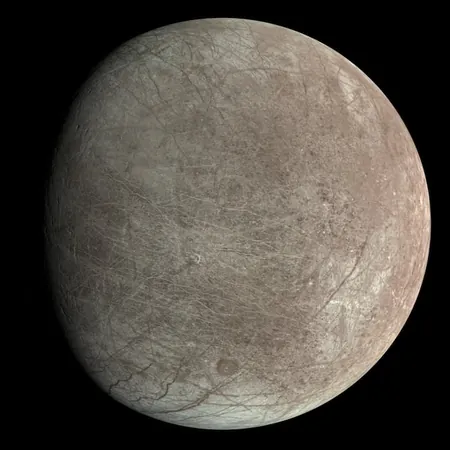
Europa: A Moon in Constant Flux Unveils Its Secrets!
2025-05-30
Author: Nur
Think icy moons are frozen in time? Think again! Europa, one of Jupiter's wondrous moons, is revealing that its surface is anything but static. Thanks to the groundbreaking observations from the James Webb Space Telescope (JWST), scientists are uncovering a dynamic world where surface ices are in perpetual motion.
Exciting Findings from the JWST!
Dr. Ujjwal Raut from the Southwest Research Institute (SWRI) reported compelling evidence from the JWST's studies. The presence of both amorphous and crystalline ice suggests that Europa has an active subsurface ocean, located about 20 miles (30 kilometers) beneath its icy shell. This discovery hints at geological activities that could be pushing material from the depths of the moon to the surface, creating a landscape constantly reshaped.
What’s Happening Under the Ice?
Orbiting within Jupiter's massive magnetic field, Europa faces relentless radiation while being tidally locked to its giant planet. This unique position leads to a relatively young geological surface, estimated to be no more than 180 million years old. The JWST's spectra reveal that ice crystallizes in various forms across the surface. Unlike Earth, where ice maintains its crystalline structure for longer due to protection from radiation, Europa’s surface ice is rapidly disrupted, converting back to amorphous forms.
Shocking Geological Features!
The JWST has unveiled surprising details about Europa's surface, especially in areas like Tara Regio where the transition between crystalline and amorphous ice occurs. Charged particles from Jupiter don't just alter the ice; they foster diverse surface features including ridges and cracks, indicating active geological processes at work. Raut emphasizes that these findings bolster our understanding of a liquid ocean hidden beneath the ice.
The Mystery of Water Delivery!
So, what catapults water to the surface? Two principal heat sources — tidal forces and radioactive decay — play key roles in warming the subsurface ocean, potentially causing chaotic terrain in regions like Tara Regio. This chaotic terrain can emerge from material forcing its way through the crust, allowing superheated water to escape and then freeze quickly upon exposure to the frigid surface.
The Unique Chemistry of Europa!
Exploring Tara Regio further, scientists have discovered intriguing materials like sodium chloride—table salt! The presence of carbon dioxide and hydrogen peroxide adds to the excitement, raising fascinating questions about their origins. Richard Cartwright, a co-author of the study, notes that the chemical landscape in this region is puzzling, with every clue leading back to its hidden internal ocean.
A Constantly Changing World!
This resilient icy surface isn't lasting long—the continuous bombardment from charged particles makes the regeneration of crystalline ice a fleeting phenomenon. In fact, newly resurfaced ice can revert back to its amorphous state within just 15 days! It's clear that Europa is not only an intriguing celestial body but a vibrant one, constantly evolving right before our eyes. Scientists are keen to delve deeper into these phenomena with upcoming missions like the Europa Clipper, poised to uncover more of this mesmerizing moon's secrets.


 Brasil (PT)
Brasil (PT)
 Canada (EN)
Canada (EN)
 Chile (ES)
Chile (ES)
 Česko (CS)
Česko (CS)
 대한민국 (KO)
대한민국 (KO)
 España (ES)
España (ES)
 France (FR)
France (FR)
 Hong Kong (EN)
Hong Kong (EN)
 Italia (IT)
Italia (IT)
 日本 (JA)
日本 (JA)
 Magyarország (HU)
Magyarország (HU)
 Norge (NO)
Norge (NO)
 Polska (PL)
Polska (PL)
 Schweiz (DE)
Schweiz (DE)
 Singapore (EN)
Singapore (EN)
 Sverige (SV)
Sverige (SV)
 Suomi (FI)
Suomi (FI)
 Türkiye (TR)
Türkiye (TR)
 الإمارات العربية المتحدة (AR)
الإمارات العربية المتحدة (AR)